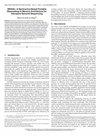基于高性能和高能效芯片系统的灵活混合互连设计
IF 1.4
3区 计算机科学
Q4 COMPUTER SCIENCE, HARDWARE & ARCHITECTURE
引用次数: 0
摘要
基于芯片组的多芯片集成在现代计算系统设计中非常普遍,因为它为提高处理能力和降低制造成本提供了一种灵活的解决方案。在基于芯片组的实施中,通过由芯片组内片上网络(NoC)和芯片组间硅内插件组成的互连网络,将单个硬件组件集成在一起,从而创建出完整的电子系统。遗憾的是,当前的互连设计已成为进一步提升性能和能效的限制因素。具体来说,由于吞吐量有限,通过硅内插器进行芯片间通信的成本很高。现有的有线片上网络(NoC)设计不利于组播和广播通信,因为带宽有限、跳数高、硬件资源有限,导致开销大、延迟长、功耗高。另一方面,无线组件可能有助于组播/广播通信,但它们需要较高的设置延迟,无法用于一对一通信。在本文中,我们提出了一种在基于芯片的系统中实现高性能和低功耗通信的混合互连设计。建议的设计由有线和无线互连组成,可适应不同的通信模式和要求。该设计提出了一种动态控制策略,可根据通信模式将所有流量分配给无线或有线硬件组件,从而实现性能最大化和功耗最小化。评估结果表明,与现有设计相比,所提出的混合设计在最大限度减少开销的情况下,平均端到端延迟降低了 8%-46%,能耗降低了 0.93-2.7 倍。本文章由计算机程序翻译,如有差异,请以英文原文为准。
A Flexible Hybrid Interconnection Design for High-Performance and Energy-Efficient Chiplet-Based Systems
Chiplet-based multi-die integration has prevailed in modern computing system designs as it provides an agile solution for improving processing power with reduced manufacturing costs. In chiplet-based implementations, complete electronic systems are created by integrating individual hardware components through interconnection networks that consist of intra-chiplet network-on-chips (NoCs) and an inter-chiplet silicon interposer. Unfortunately, current interconnection designs have become the limiting factor in further scaling performance and energy efficiency. Specifically, inter-chiplet communication through silicon interposers is expensive due to the limited throughput. The existing wired Network-on-Chip (NoC) design is not good for multicast and broadcast communication because of limited bandwidth, high hop count and limited hardware resources leading to high overhead, latency and power consumption. On the other hand, wireless components might be helpful for multicast/broadcast communications, but they require high setup latency which cannot be used for one-to-one communication. In this paper, we propose a hybrid interconnection design for high-performance and low-power communications in chiplet-based systems. The proposed design consists of both wired and wireless interconnects that can adapt to diverse communication patterns and requirements. A dynamic control policy is proposed to maximize the performance and minimize power consumption by allocating all traffic to wireless or wired hardware components based on the communication patterns. Evaluation results show that the proposed hybrid design achieves 8% to 46% lower average end-to-end delay and 0.93 to 2.7× energy saving over the existing designs with minimized overhead.
求助全文
通过发布文献求助,成功后即可免费获取论文全文。
去求助
来源期刊

IEEE Computer Architecture Letters
COMPUTER SCIENCE, HARDWARE & ARCHITECTURE-
CiteScore
4.60
自引率
4.30%
发文量
29
期刊介绍:
IEEE Computer Architecture Letters is a rigorously peer-reviewed forum for publishing early, high-impact results in the areas of uni- and multiprocessor computer systems, computer architecture, microarchitecture, workload characterization, performance evaluation and simulation techniques, and power-aware computing. Submissions are welcomed on any topic in computer architecture, especially but not limited to: microprocessor and multiprocessor systems, microarchitecture and ILP processors, workload characterization, performance evaluation and simulation techniques, compiler-hardware and operating system-hardware interactions, interconnect architectures, memory and cache systems, power and thermal issues at the architecture level, I/O architectures and techniques, independent validation of previously published results, analysis of unsuccessful techniques, domain-specific processor architectures (e.g., embedded, graphics, network, etc.), real-time and high-availability architectures, reconfigurable systems.
 求助内容:
求助内容: 应助结果提醒方式:
应助结果提醒方式:


